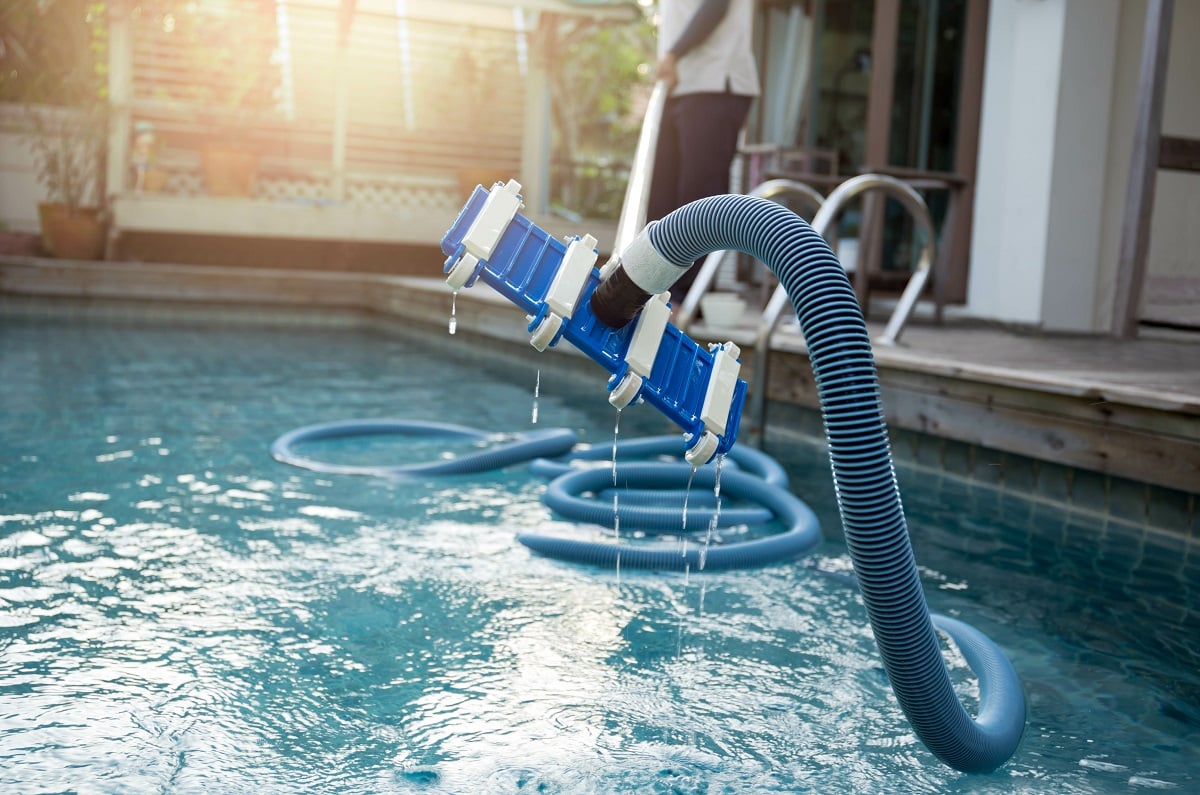Robotic Pool Cleaner vs Suction Pool Cleaners - Which Should I Buy?
All pools, DIY pools included, need to be cleaned. If a robot cleaner went nine rounds with a suction cleaner, who would win the title? Which does a better job of cleaning your pool in the least amount of time? Do you put some of your budget towards buying a robotic pool cleaner, suction pool cleaner or stick with manually vacuuming your pool? It's time to clean up (oh, how we love a dad joke!) some of the myths and talk facts.
Before you jump online to buy your new toy, why do you need a pool cleaner? While your pump and filter do a great job, particles, leaves, hair, dirt, dust etc will settle on the floor of your pool. Aside from looking dirty, bacteria enjoys feeding on organic matter and some leaves can leave a stain if left for long time. Black Spot Algae will also be interested in attaching to your pool walls and floor, particularly in porous concrete pools. Learn more about whether concrete or fibreglass pools are easier to maintain here.
Just like your floors at home need vacuuming and mopping, pools need to be frequently broomed down and vacuumed to prevent cloudy water, bacteria growth and algae blooms.
There are three main options - manual vacuums, suction cleaners and robotic cleaners.
Manual Pool Cleaners 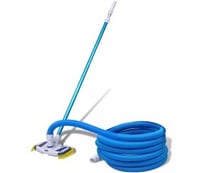
These are like your home vacuum. A vacuum head with rollers is attached to an extendable pole so you can push it around your pool floor. Suction comes from connecting a hose to the vacuum head and your skimmer box and turning on your pump. Just add a human (usually Mum or Dad. Younger kids are too busy swimming to clean! Teenagers are busy being teenagers) and 30 minutes later you should be done. To prevent Black Spot Algae and bacteria growth, manually brush down the walls, steps and corners etc and allow the particles to settle for an hour before vacuuming. If you have a variable speed pump, run your pump on high while vacuuming. If you bought your DIY pool through us, a manual pool cleaner is included free and most pool builders include a manual cleaner as well. Click here to learn more about single speed and variable speed pumps.
Anything that the vacuum sucks up will go into your filter which usually means you will be backwashing your media filter or cleaning your cartridge filter more often. If the dust or dirt is finer than your filter captures, it will stay in your pool and take some of the sparkle out of your water until it settles on the floor again. Change sand media to glass media to solve this or swap your cartridge filter element for a finer mesh element. The most common gripe with manual cleaners is uncoiling the 10m+ hose and coiling it back up to store it along with flooding the hose to remove air before turning the pump on. Outside of that, they do a great job and are very affordable to buy.
Suction Pool Cleaners 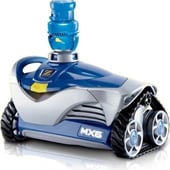
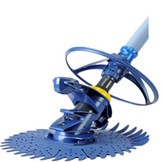
Suction pool cleaners are an economical semi-automatic version of a manual vacuum. Setting up a suction pool cleaner is similar to a manual vacuum by attaching the vacuum hose to the skimmer box. The difference is you can throw it in the water and walk away. When the pump comes on, the cleaner will move around the pool floor and up the walls vacuuming everything in its path. As it moves around in random patterns, sections often get missed which need manual vacuuming. Suction cleaners also don't scrub walls and floors so you'll still need to broom floors and walls down. If you assume a suction cleaner will vacuum 75% of your pool and that you will still need to broom off walls, floors, steps, corners, ledges etc, you won't be disappointed.
As the cleaner is attached to the skimmer box, leaves and other debris that would normally be skimmed from the surface of your pool into your skimmer box will end up on your pool floor while the suction cleaner is in the pool.
Plenty of people leave their suction cleaner in the pool continuously. The volume of water through the filter can drop with suction cleaners, so if you leave your suction cleaner attached all day, every day, monitor your water quality initially and increase your single speed pump running time if it is becoming cloudy. If you have a variable speed pump, run it on the high speed setting. While leaving the suction cleaner constantly in your pool, you will notice an increase in your pump power consumption and power bill. Make sure you keep a close watch on your pH and chlorine levels as rubber and plastic don’t like either in too high a concentration and will shorten your cleaners life. For the lowest power bill and your suction cleaner having a long life, take your cleaner out of the pool once it is clean.
The main downside of a suction pool cleaner is draining and coiling up the 10+m long vacuum hose after each use and the annual replacement of plastic and rubber parts that wear out. If you have loads of berries or the dreaded palm tree nuts falling into your pool, these can block some cleaners diaphragms so check with your supplier about this before parting with your hard earned cash. If your pool has right angle corners where the pool wall meets the floor of the pool, suction cleaners can tend to get stuck and need to be manually moved.
Quality suction cleaners range between $380 and $1,000. You will annually spend around $100 to $150 on consumables that wear out like diaphragms, retaining rings and curtains. Suction cleaners are a budget friendly upgrade from manual cleaning and will save you plenty pool maintenance time.
Robotic Pool Cleaners 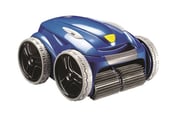
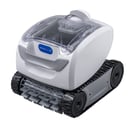
We so want to make a Lost in Space reference here. Alas, no. If you are looking for a pool cleaner that will learn the shape of your pool, can be controlled from your smart phone and is completely independent of your filtration system, you might start mumbling “robotic pool cleaner” in your sleep. Note: this is the top of the range model functionality.
Robotic cleaners plug into a standard power point and can be dropped into your pool. A transformer in the unit converts the power to a safe low voltage level which in turn powers the wheels or tracks that move it around your pool (the power cable is usually 15m to 18m long). Robotic pool cleaners vacuum straight into its own filter compartment (like your vacuum at home) and will suck up all sizes of debris. This is why they are also referred to as “self contained units”. As the debris is not going into your filter, you’ll notice your filter will need less backwashing or cartridge cleaning and your chemical consumption dropping.
Basic model robots use a pre-set cleaning pattern to clean your floors only (cheapest option) or floors, walls and waterline (slightly more expensive). In addition to suction cleaning, they usually have a scrubbing brush which means you don't have to manually broom down your walls and floors as you do with manually vacuuming and suction cleaners. If you assume a basic robot will clean 85% of your pool and you still need to broom off steps, ledges and corners, you won't be disappointed.
Top of the range robots have multiple cleaning modes (usually a quick floor only mode, standard floor, wall and waterline mode and full deep clean mode), are controllable through a smart phone app for spot cleaning and can be programmed to start and stop at set times. These NASA like beasts will scan the shape of your pool and customise its cleaning pattern however they are still not great at getting onto steps and ledges. If you assume it will clean 95% of your pool with a bit of step and ledge brooming needed, you'll be happy with your new toy.
If you notice dust or dirt coming out of the back of the robot, it doesn't mean it is broken. The dust and dirt is too fine for the filter to capture. Swapping the filter element to 100 micron or 50 micron will solve the problem. Always check how much the unit weighs as you need to be able to pull the robot from the water. Cheaply made robots tend to be heavier than a quality robot. Also check if the robot has a self draining function which removes any water from the unit before taking it from the pool as this makes it considerable lighter. Most robots weigh between 5kg and 10kg and plenty of models include a two wheel trolley (caddy) for ease of taking the robot to the pool and back to the shed.
Being low voltage, they are economical on electricity use. As they do not rely on your pump and filter to operate, your skimmer box will collect surface debris and your pump can run on its lowest power setting for daily operation while your robot cleaner goes to work. While they cost more to buy, the operational cost per year is considerably lower than a suction cleaner.
The downside is with all that extra time relaxing next to your pool instead of cleaning it, you’ll be able to think what your new robot friend cost. Entry level models that are any good will start around $1,100. All the bells and whistles including artificial intelligence and remote smart phone operation are up to $2,800. Start dropping Christmas present hints early!
Key Takeaway
Whether it is you, a pool cleaning service or the house guest, someone has to vacuum and broom your pool regularly including in winter when there are icebergs in the water. Manual vacuums work just fine. If budget is tight, start there and look at upgrades later on. The decision to upgrade to a suction cleaner or robotic cleaner comes down to whether you are happy to trade a higher upfront cost for less time maintaining your pool. If you can invent a way that is really low cost and fully automatic, let us know and we’ll all be rich!
Related Blogs
When it comes to backyard swimming pools, fibreglass options often come out on top. They are fast to install, low maintenance, and last for decades. But are they perfect for everyone? Not necessarily.
Thinking about joining the world of fibreglass pools? You might feel like you’ve stumbled into a whole new language of coping, skimmers, gelcoats... What the heck does it all mean?
Thinking about installing your own fibreglass pool in New South Wales? Good on you — done right, DIY pools can save you serious money without cutting quality and still look like a pro job. But....
About The Author
My wife and I grew up playing in swimming pools. Our daughters learnt to swim in our backyard fibreglass swimming pool. There is nothing quite like hearing kids splashing about and giggling. As pools do, our pool became a social magnet for friends, family and neighbours which we loved. Helping customers to have their own pool and saving customers thousands on their pool and equipment is the best job in the world.




















